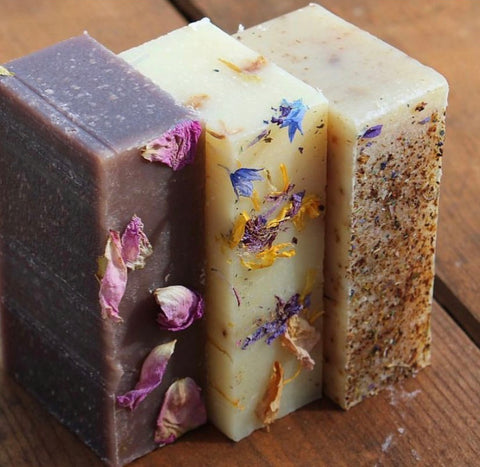Creating colourful soaps North of 60.

Have you ever wondered how we make our soaps naturally vibrant and colourful without adding artificial dyes? Today, we’re giving you the secret to three ways we colour our soaps.
There’s a unique challenge to making colourful natural soap. Finding natural additives and colours takes a lot of research and creating the colours involves a more time-consuming process than using store-bought dyes. We use the cold process soap making method which can change the color of some additives that you think might be beautiful. When we started making soap, we experimented with cranberries, blueberries and other gifts found in the forest around us. Unfortunately, the chemical reaction that takes place turns those vibrant colors into various shades of brown.
We love is having our hands in every step of the process. Each bar of soap is one of a kind and infused with care—something we hope you feel when you use our products.
Oil infusions
The color we create the most through the infusion process is pink using alkanet root. It is often used to add colour to natural fibres as it has a beautiful bright red or purple tone. This ingredient is what adds a rosy purple hue to our Yukon Wild Rose soap. We add the alkanet root powder to oil, leaving the powder to infuse until the colour is where we like it. The amount of powder and the length of time it infuses can affect how pigmented the colour is. We can accelerate the process with heat. The we strain the root powder from the oil. And because it is a natural product, we get a slight colour variation in each bar we create.
Direct to pot

Wondering how we get the swirl of red brown into the Aurora's Passion bar? After the rosehips are harvested, they are dried and then ground up in a coffee grinder. We then sift out all of the seeds so that what remains is the outer shell of the lovely hips. The swirl effect is created by separating the batch into smaller amounts and adding dried rosehips into one of them. Then we pour the separate soap mixtures into the mold and use a rubber spatula to swirl them into the desired effect. You can use almost anything: spices, seeds, or coffee. We also like to use ground labrador tea and yarrow that we can harvest ourselves. The oil helps the materials to disperse evenly before it’s blended with the soap. This method has the added bonus of creating a gentle exfoliation.
Rolling and pressing
Dried flowers and herbs are like the sprinkles on an ice cream sundae—they just add that little bit of vibrancy and brightness. There are many options to choose from, but some of our Yukon favourites are fireweed and rose petals, and juniper berries.
With this technique, we sprinkle the soap with flowers then gently roll it and press it with a rolling pin. Then cut the bars. There are a few tricks for using dried flowers. Firstly, make sure your materials are properly dried and ready before adding them to your soap, if not they can turn brown quickly or even mold. And secondly, your soap should be cured but still soft so the flowers can anchor themselves in the soap.

What’s your favourite colouring process? Get in touch via email or social media!
About the Author

Kia ora! Holly Edmonds (she/her) is a Māori writer and editor who has spent her formative years in the Yukon. Holly loves to collaborate with badass Indigenous women and help them to tell their unique stories.
Kia ora! He kaituhi, he kaietita Māori a Holly Edmonds. I ōna tau taiohi i noho ia ki te Yukon. He rawe ki a ia te mahi ngātahi ki ngā wāhine taketake whakatete hei āwhina i a rātou ki te whakaputa i ō rātou kōrero ahurei.


Leave a comment